Experimental and Simulated Investigations of Thin Polymer Substrates with an Indium Tin Oxide Coating under Fatigue Bending Loadings
Abstract
:1. Introduction
2. Experimental Details of the ITO-PET Film
2.1. Establishment of the Bending Test Mechanism and Bending Experiment
2.2. Sheet Resistance Measurement
2.3. Observation of ITO Film Failure and Optical Transmittance Measurement
3. Experimental Results and Discussion
4. Validation and Simulation Approaches of Fracture-Based Analysis for ITO-PET Thin Films
4.1. Energy-Based Method of Adhesion Strength Estimation: J-Integral Approach
4.2. Validation of Interfacial Adhesion Strength of Selected ITO-PET Film
4.3. Influence of Crack Length, PET Thickness, and ITO Thickness on Energy Release Rate Estimation
4.3.1. Influence of Crack Length on J-Value Predication
4.3.2. Thickness Effect of PET Compliant Substrate
4.3.3. Thickness Effect of ITO-Coating on PET Substrate
5. Conclusions
Acknowledgments
Author Contributions
Conflicts of Interest
References
- Li, Z.-H.; Cho, E.S.; Kwon, S.J. Laser direct patterning of the T-shaped ITO electrode for high-efficiency alternative current plasma display panels. Appl. Surf. Sci. 2010, 257, 776–780. [Google Scholar] [CrossRef]
- Lee, U.J.; Lee, S.H.; Yoon, J.J.; Oh, S.J.; Lee, S.H.; Lee, J.K. Surface interpenetration between conducting polymer and PET substrate for mechanically reinforced ITO-free flexible organic solar cells. Sol. Energy Mater. Sol. Cells 2013, 108, 50–56. [Google Scholar] [CrossRef]
- Lue, C.E.; Wang, I.S.; Huang, C.H.; Shiao, Y.T.; Wang, H.C.; Yang, C.M.; Hsu, S.H.; Chang, C.Y.; Wang, W.; Lai, C.S. pH sensing reliability of flexible ITO/PET electrodes on EGFETs prepared by a roll-to-roll process. Microelectron. Reliab. 2012, 52, 1651–1654. [Google Scholar] [CrossRef]
- Zimmermann, B.; Schleiermacher, H.F.; Niggemann, M.; Würfel, U. ITO-free flexible inverted organic solar cell modules with high fill factor prepared by slot die coating. Sol. Energy Mater. Sol. Cells 2011, 95, 1587–1589. [Google Scholar] [CrossRef]
- Lee, C.C. Modeling and validation of mechanical stress in indium tin oxide layer integrated in highly flexible stacked thin films. Thin Solid Film 2013, 544, 443–447. [Google Scholar] [CrossRef]
- Sasabayshi, T.; Ito, N.; Nishimura, E.; Kon, M.; Song, P.K.; Utsumi, K.; Kaijo, A.; Shigesato, Y. Comparative study on structure and internal stress in tin-doped indium oxide and indium-zinc oxide films deposited by r.f. magnetron sputtering. Thin Solid Film 2003, 445, 219–223. [Google Scholar] [CrossRef]
- Guyot, N.; Harmand, Y.; Mézin, A. The role of the sample shape and size on the internal stress induced curvature of thin-film substrate systems. Int. J. Sol. Struct. 2004, 41, 5143–5154. [Google Scholar] [CrossRef]
- Kim, E.H.; Kim, G.; Lee, G.H.; Park, J.W. Nucleation and growth of crystalline Indium Tin Oxide (ITO) coatings on polyethylene terephthalate (PET). Surf. Coat. Technol. 2010, 205, 1–8. [Google Scholar] [CrossRef]
- Grego, S.; Lewis, J.; Vick, E.; Temple, D. Development and evaluation of bend-testing techniques for flexible-display applications. J. Soc. Inf. Disp. 2005, 13, 575–581. [Google Scholar] [CrossRef]
- Lin, Y.C.; Shi, W.Q.; Chen, Z.Z. Effect of deflection on the mechanical and optoelectronic properties of indium tin oxide films deposited on polyethylene terephthalate substrates by pulse magnetron sputtering. Thin Solid Film 2009, 517, 1701–1705. [Google Scholar] [CrossRef]
- Lan, F.F.; Peng, C.W.; Lo, Y.H.; He, J.L. Durability under mechanical bending of the indium tin oxide films deposited on polymer substrate by thermionically enhanced sputtering. Org. Electron. 2010, 11, 670–676. [Google Scholar] [CrossRef]
- Hamasha, M.M.; Alzoubi, K.; Lu, S. Behavior of sputtered indium–tin–oxide thin film on poly-ethylene terephthalate substrate under stretching. J. Disp. Technol. 2011, 7, 426–433. [Google Scholar] [CrossRef]
- Alzoubi, K.; Hamasha, M.M.; Lu, S.; Sammakia, B. Bending fatigue study of sputtered ITO on flexible substrate. J. Disp. Technol. 2011, 7, 593–600. [Google Scholar] [CrossRef]
- Hamasha, M.M.; Dhakal, T.; Alzoubi, K.; Albahri, S.; Qasaimeh, A.; Lu, S.; Westgate, C.R. Stability of ITO thin film on flexible substrate under thermal aging and thermal cycling conditions. J. Disp. Technol. 2012, 8, 385–390. [Google Scholar] [CrossRef]
- Lee, Y.C.; Liu, T.S. Torsional analysis and measurement for flexible displays. J. Solid Mech. Mater. Eng. 2011, 5, 476–483. [Google Scholar] [CrossRef]
- Lee, Y.C.; Liu, T.S.; Chang, P.Y.; Ku, Y.S. On substrate behavior of flexible displays subject to torque. J. Soc. Inf. Disp. 2011, 19, 1–8. [Google Scholar] [CrossRef]
- Sytchkova, A.; Zola, D.; Bailey, L.R.; Mackenzie, B.; Proudfoot, G.; Tian, M.; Ulyashin, A. Depth dependent properties of ITO thin films grown by pulsed DC sputtering. Mater. Sci. Eng. B 2013, 178, 586–592. [Google Scholar] [CrossRef]
- Gere, J.M.; Timoshenko, S.P. Mechanics of Materials; Fourth SI; Nelson Thornes Ltd.: Cheltenham, UK, 1999. [Google Scholar]
- Chen, Z.; Cotterell, B.; Wang, W. The fracture of brittle thin films on compliant substrates in flexible displays. Eng. Fract. Mech. 2002, 69, 597–603. [Google Scholar] [CrossRef]
- Rice, J.R. A path independent integral and the approximate analysis of strain concentration by notches and cracks. J. Appl. Mech. 1968, 35, 379–386. [Google Scholar] [CrossRef]
- Lee, C.C.; Shen, Y.L.; Kang, Y. Prediction of interfacial adhesion strength of nanoscale Al/TiN films passed through patterned BEOL interconnects. Mater. Sci. Semicond. Process. 2015, 39, 1–5. [Google Scholar] [CrossRef]
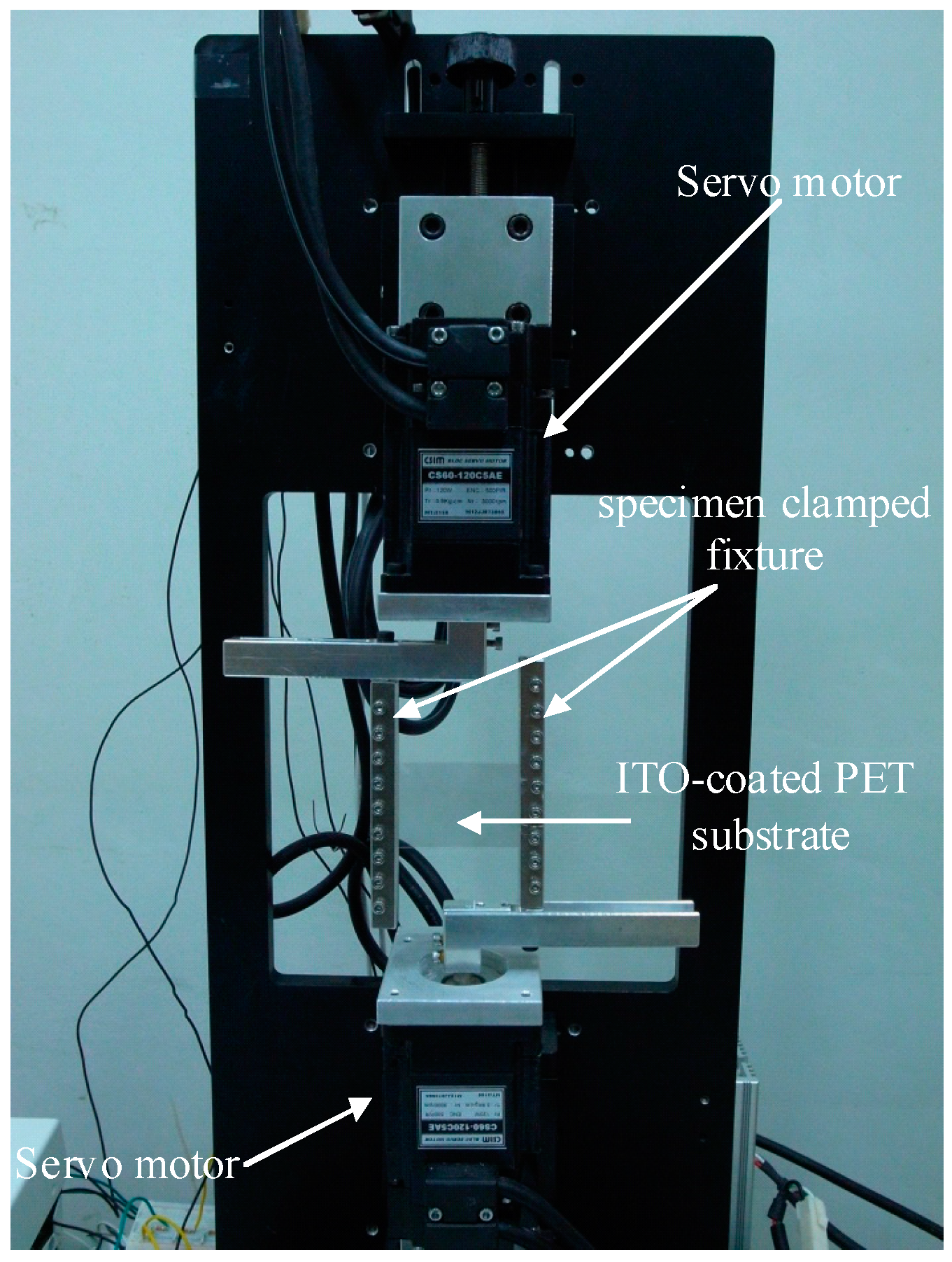
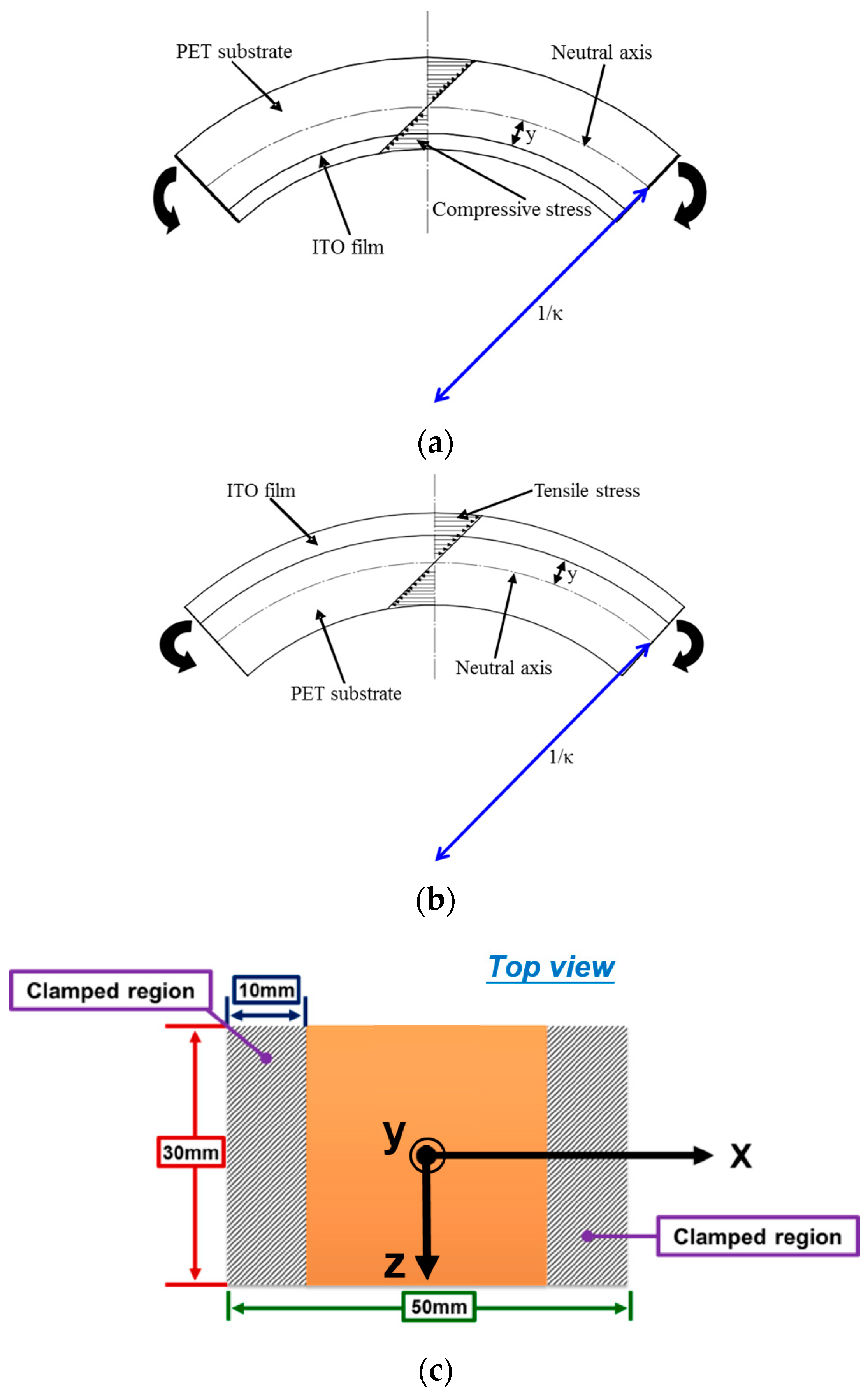

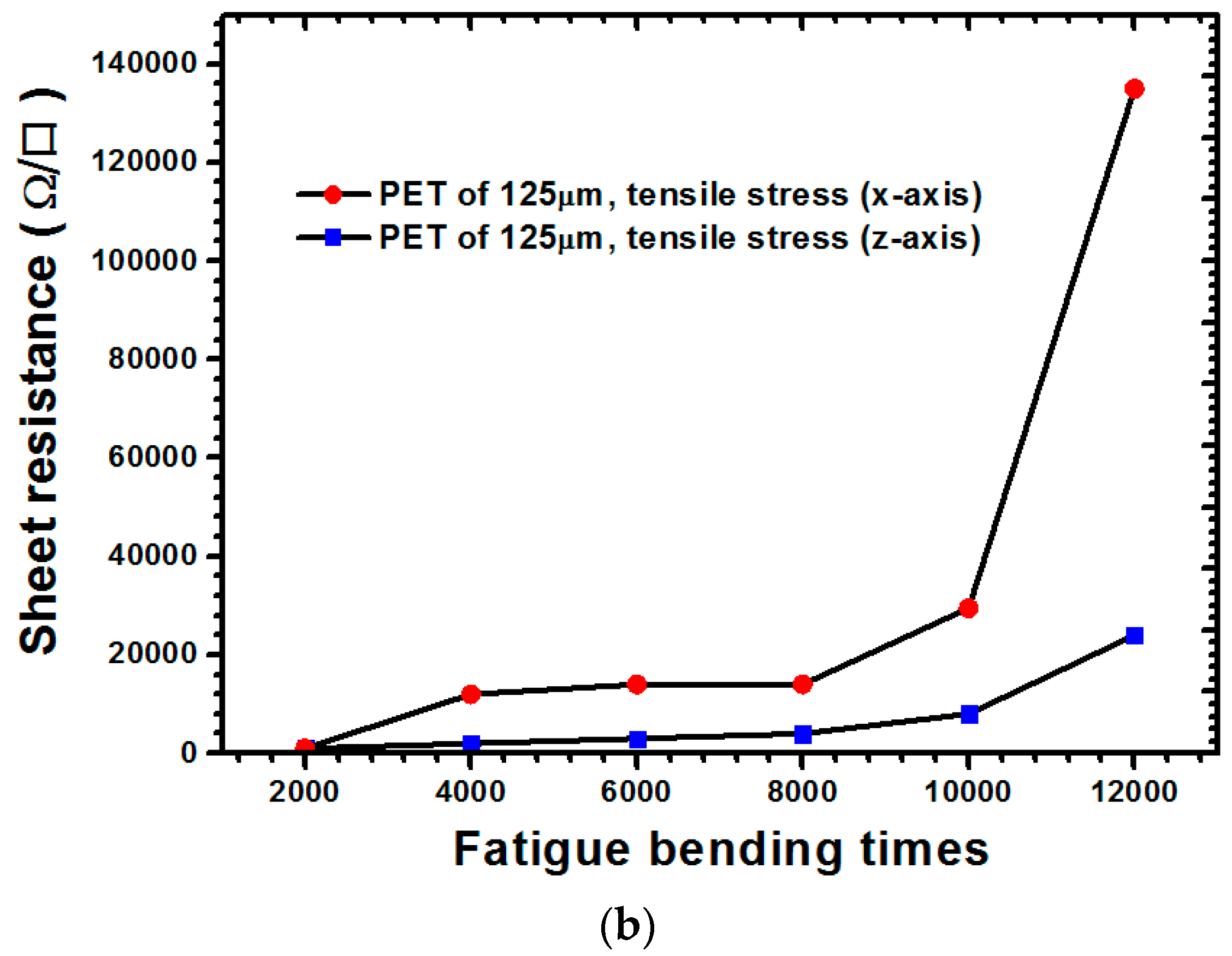
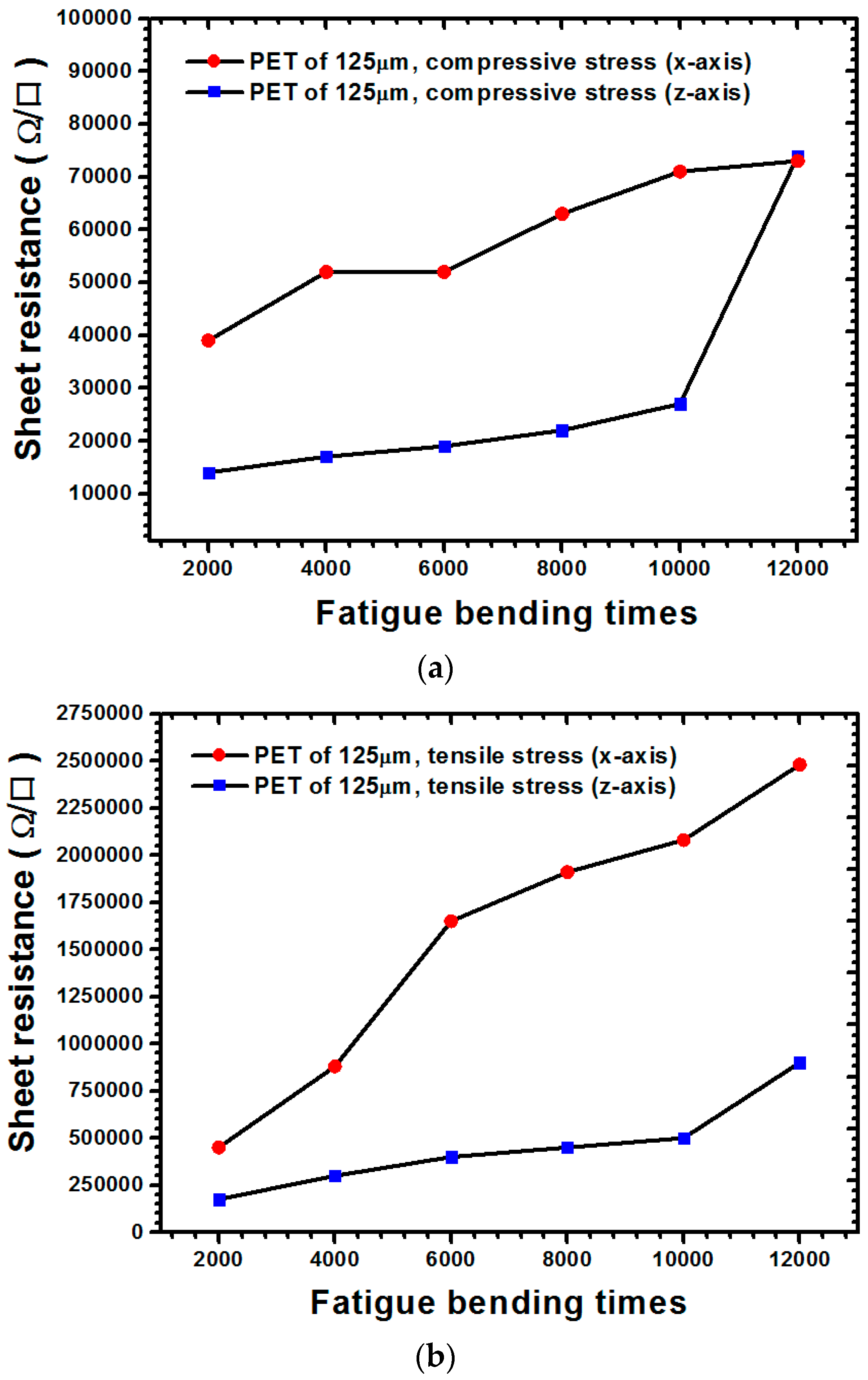
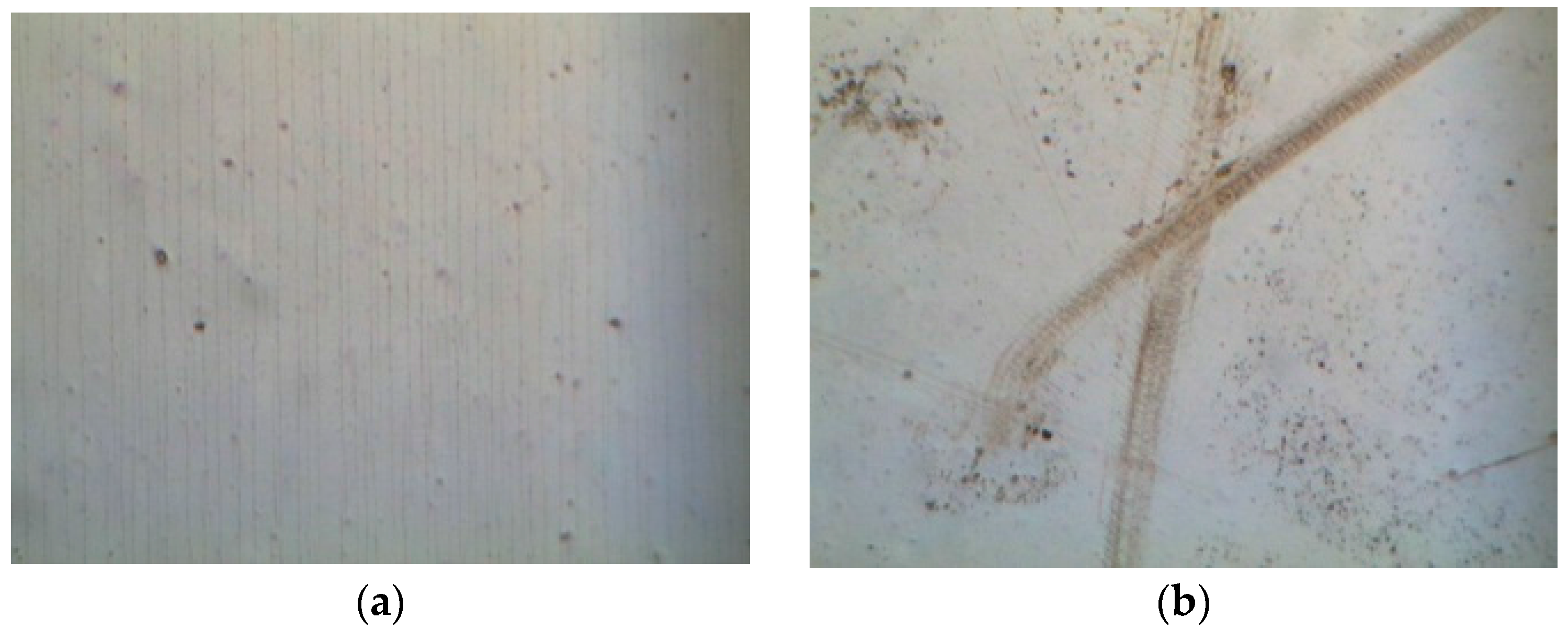
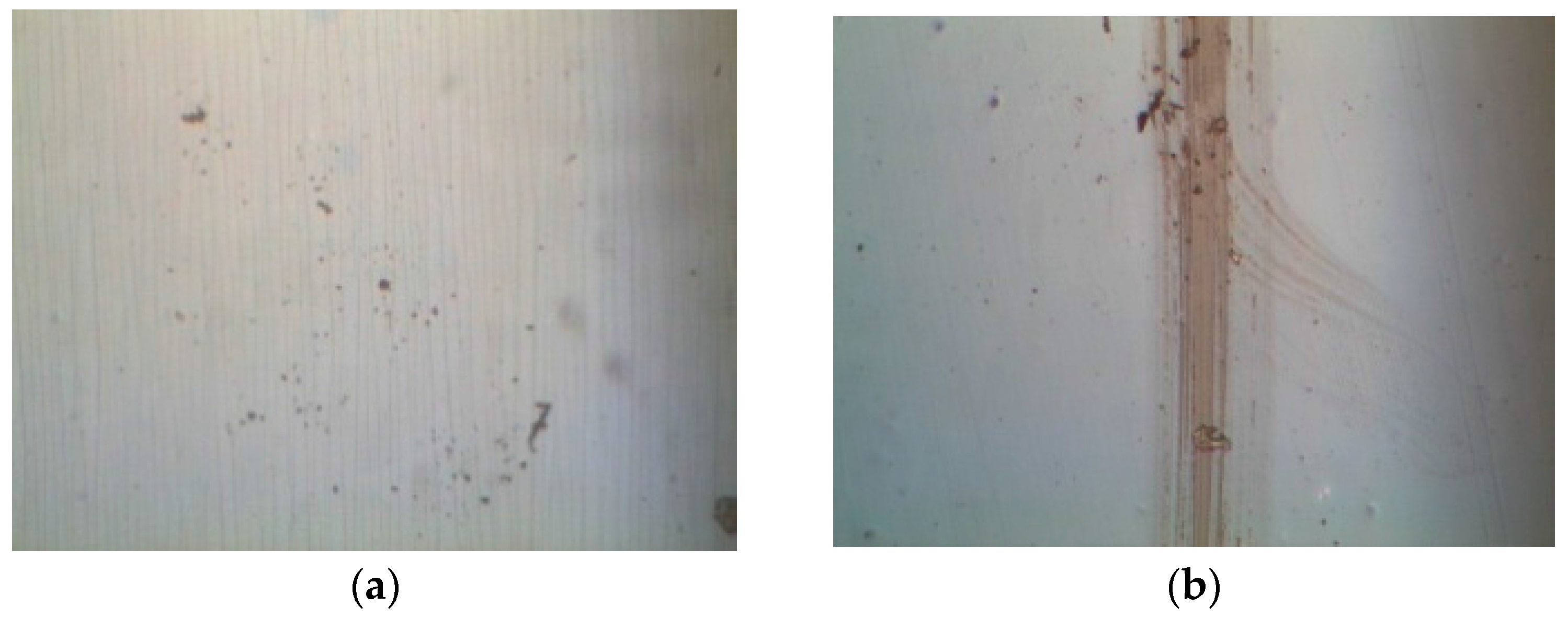
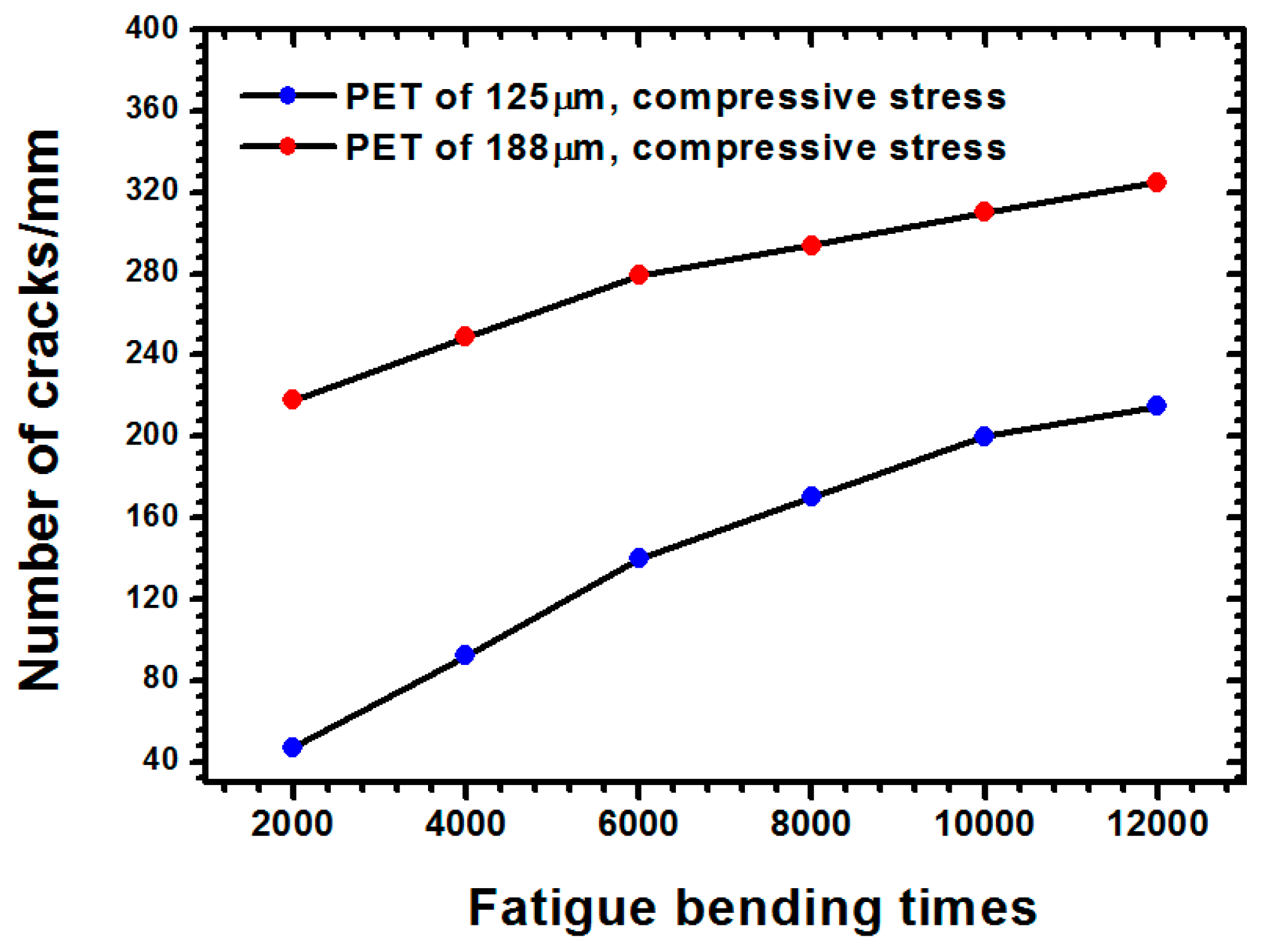

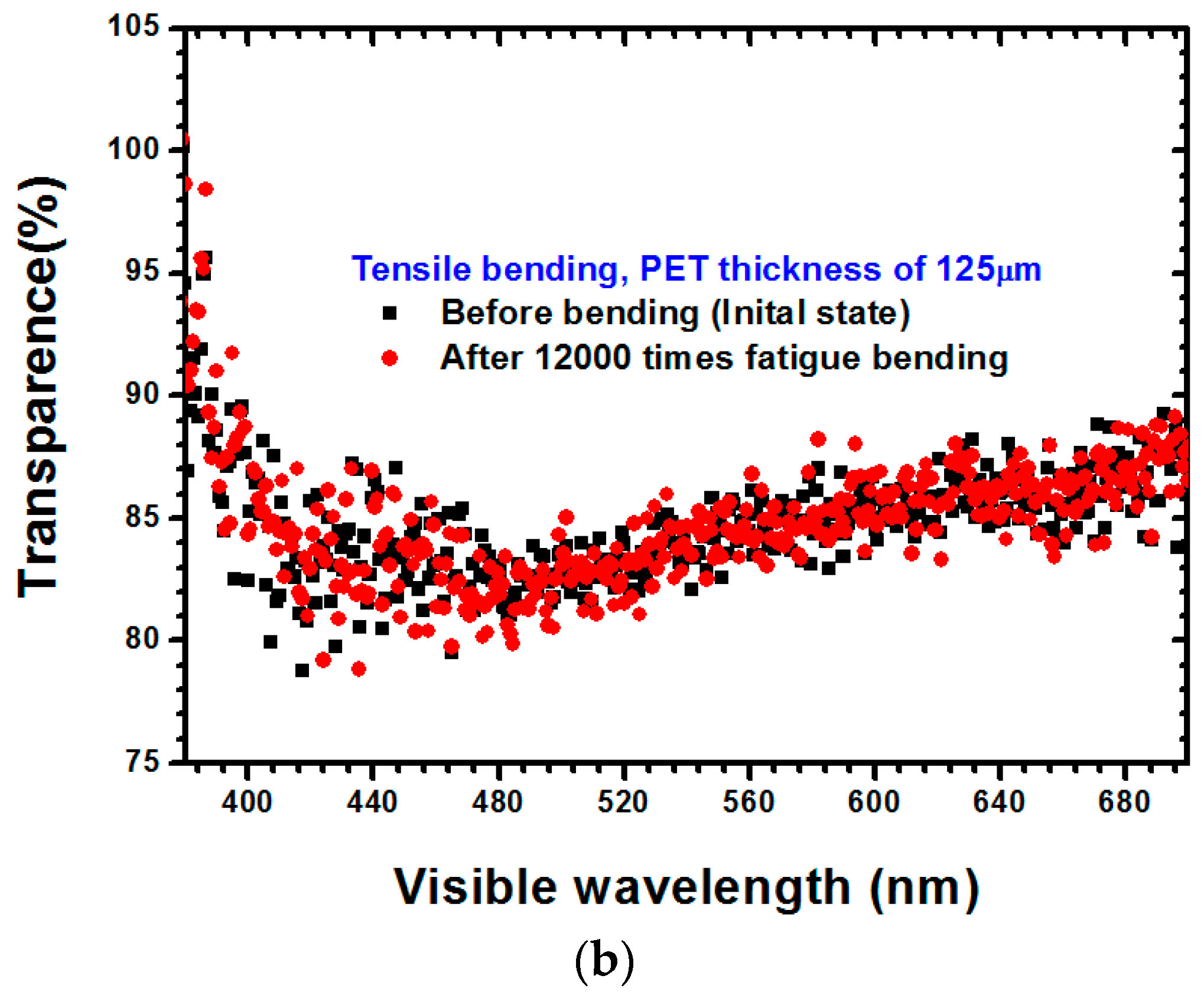
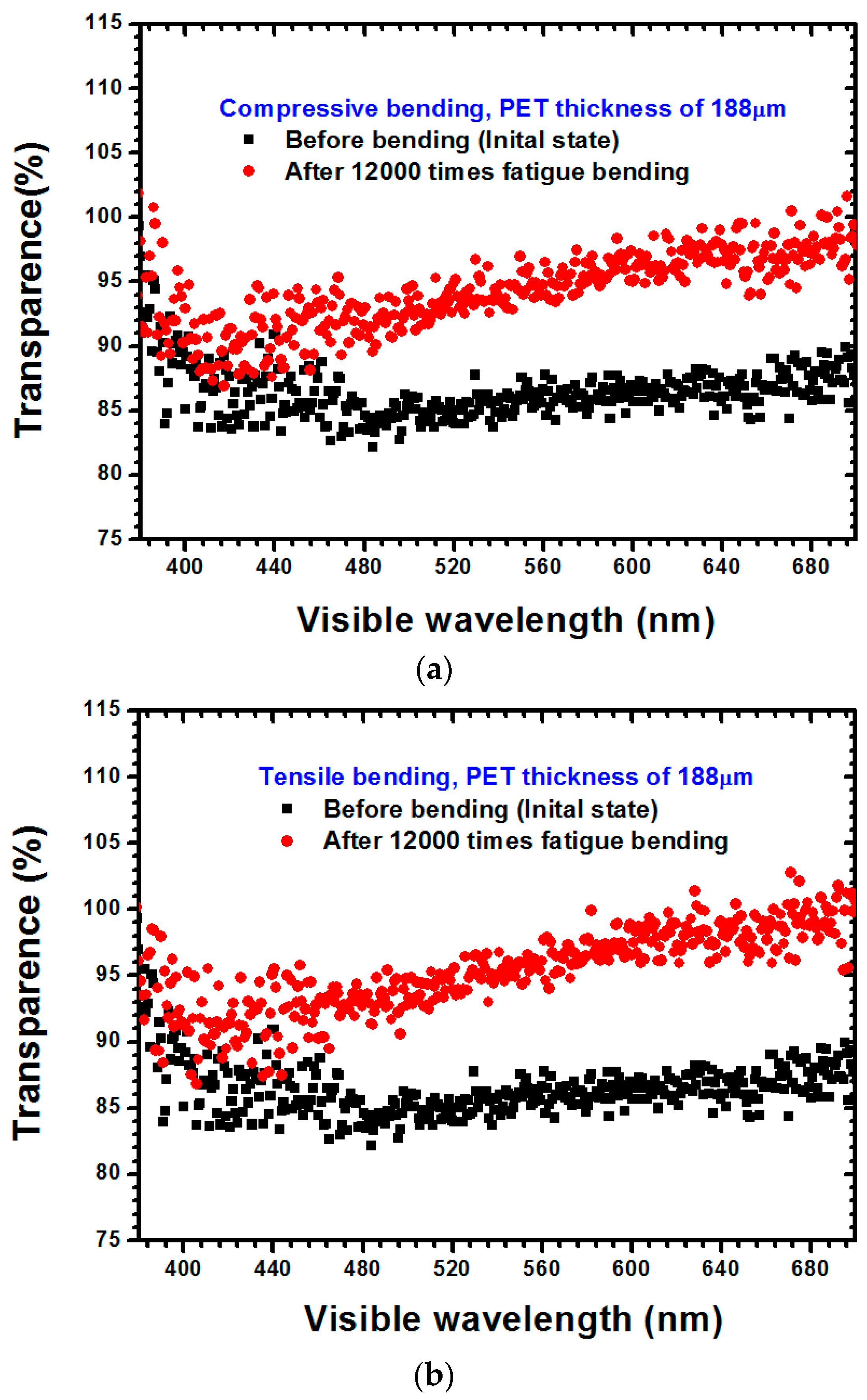
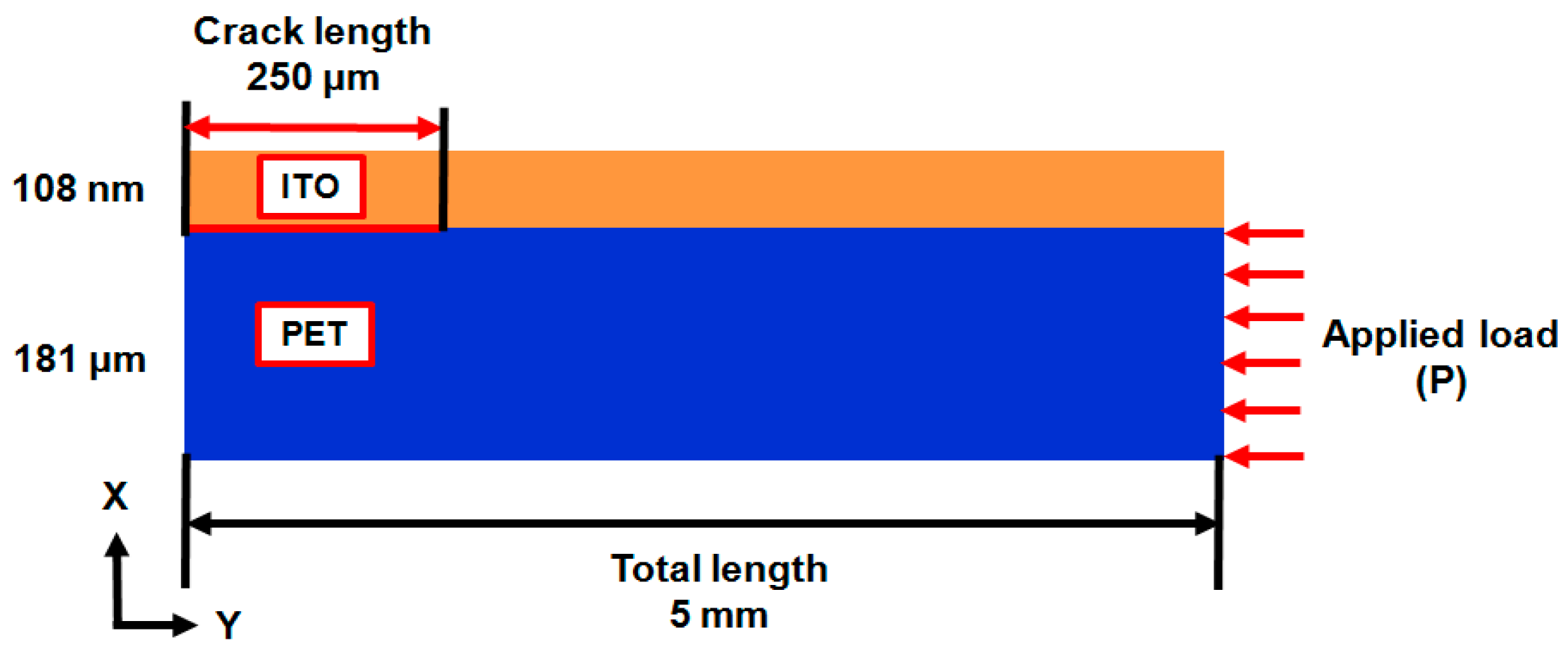
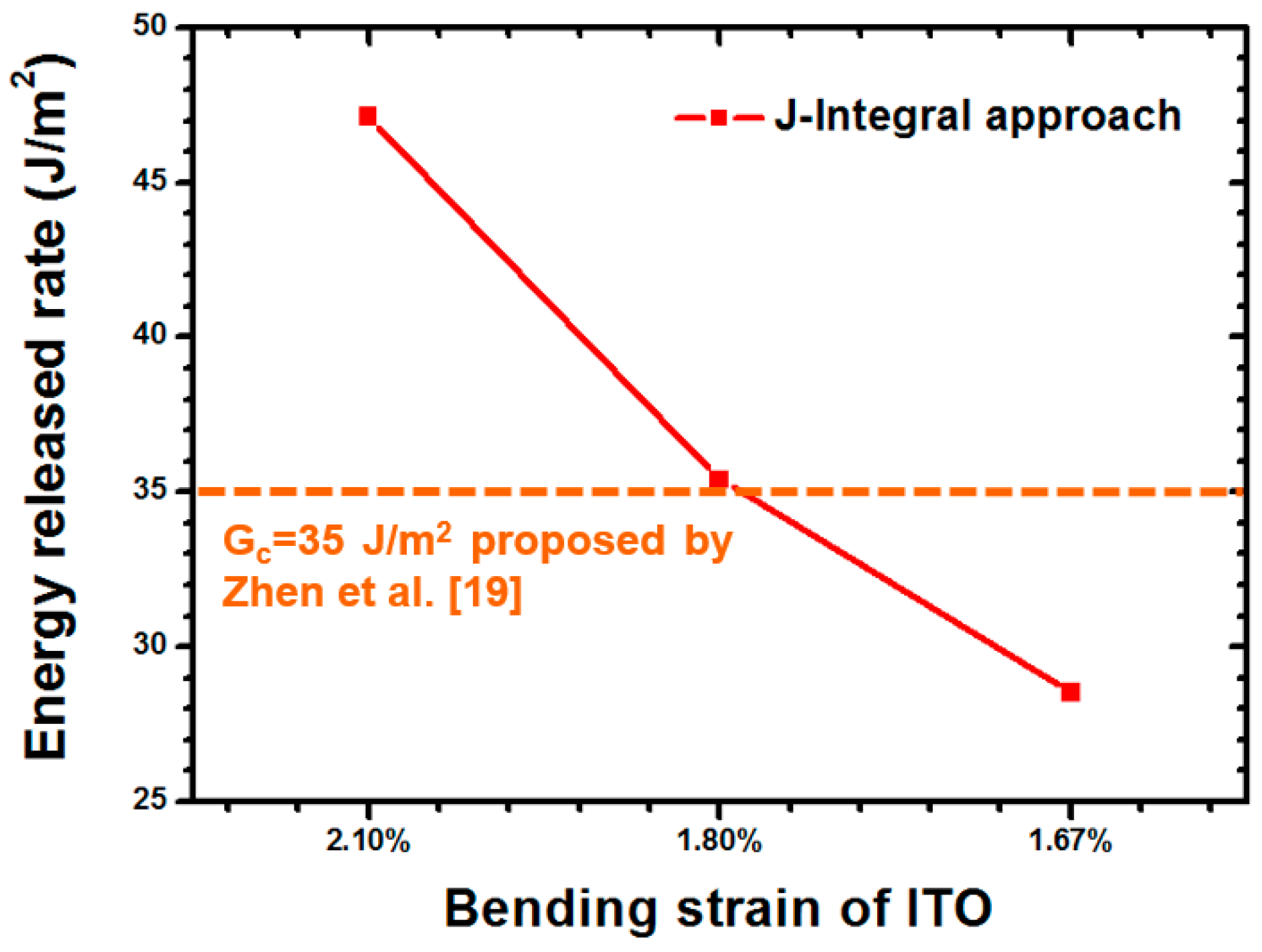
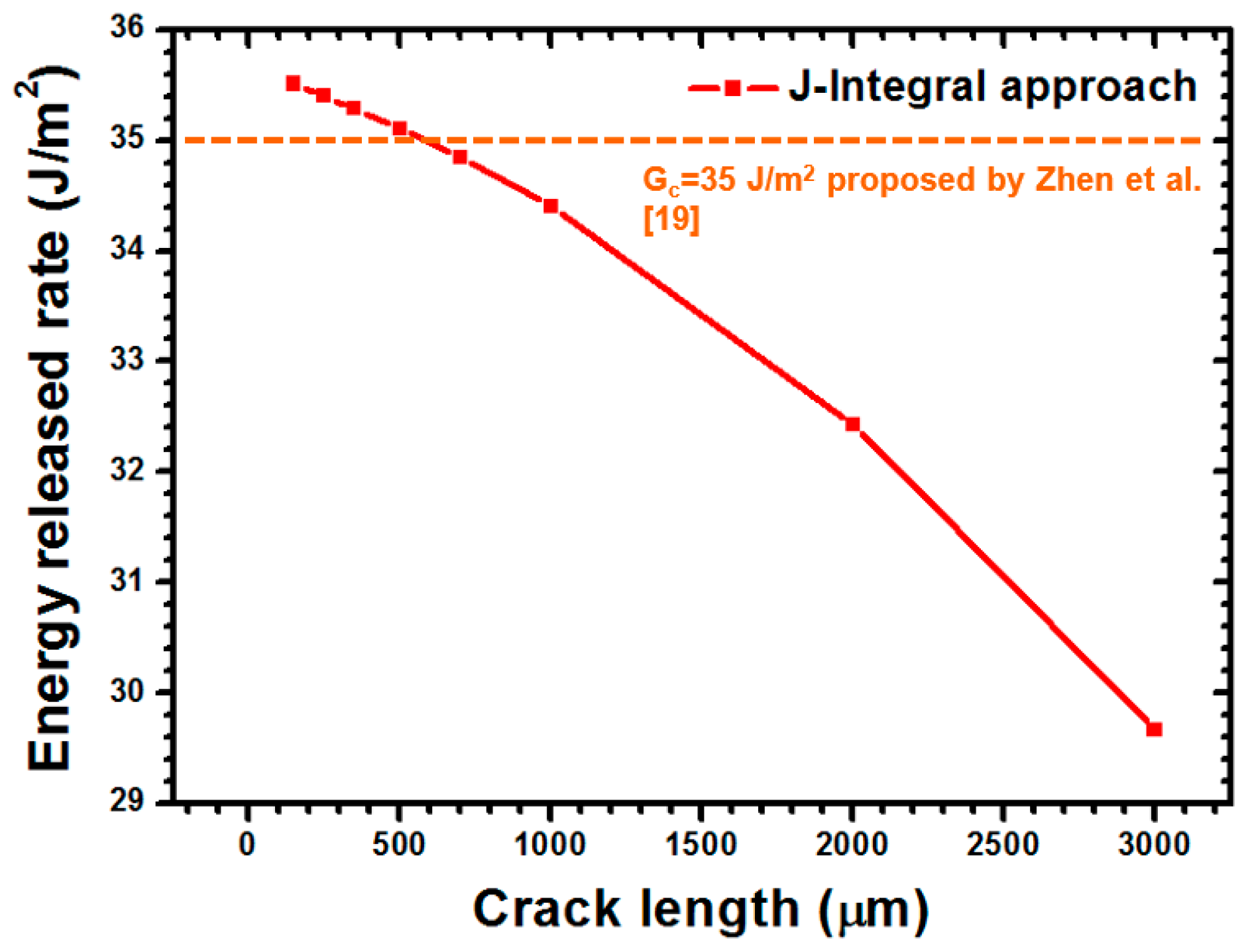
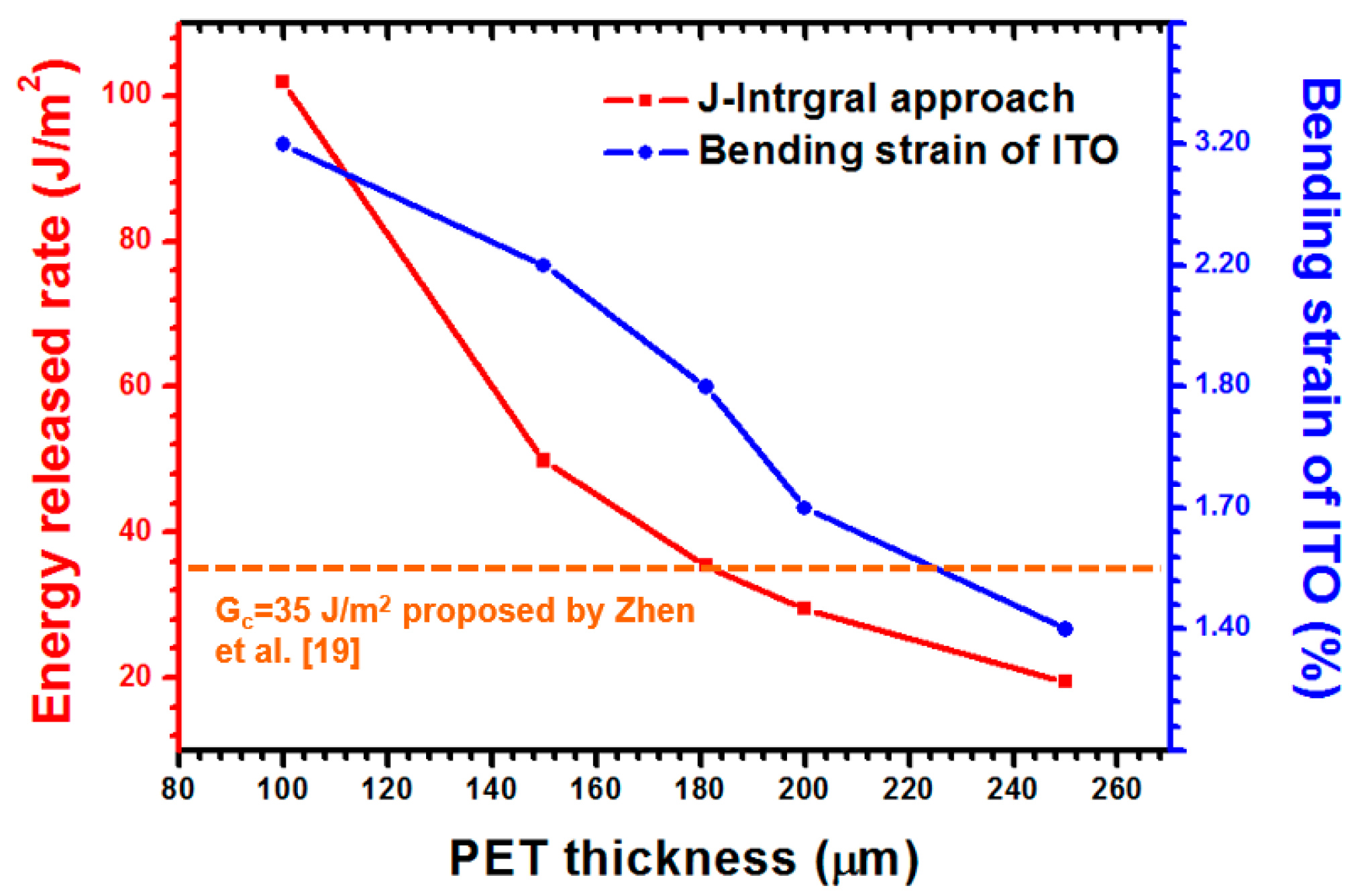
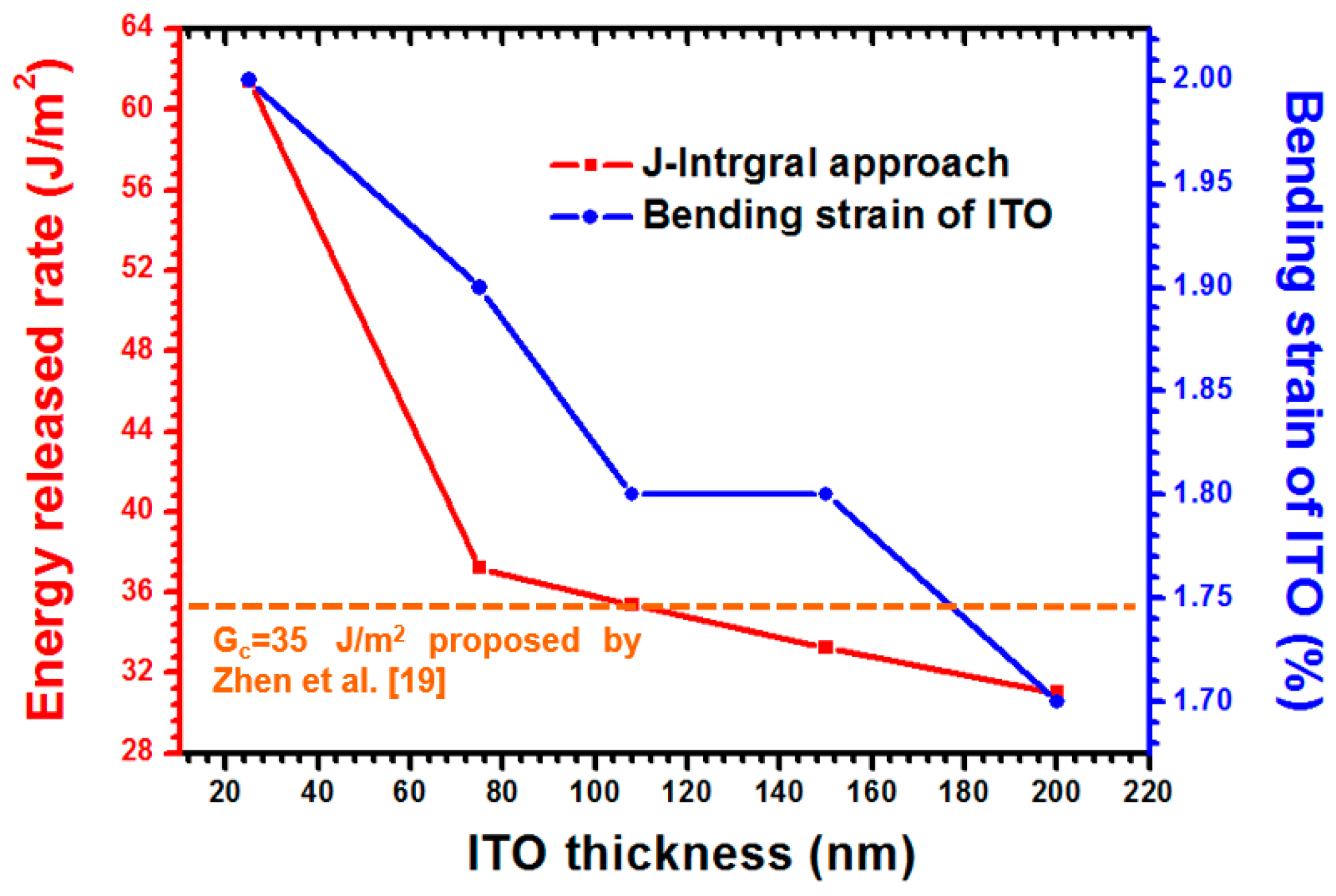
| Materials | Young’s Modulus (GPa) | Poisson’s Ratio |
|---|---|---|
| ITO | 118 | 0.3 |
| PET | 3.1 | 0.4 |
© 2016 by the authors; licensee MDPI, Basel, Switzerland. This article is an open access article distributed under the terms and conditions of the Creative Commons Attribution (CC-BY) license (http://creativecommons.org/licenses/by/4.0/).
Share and Cite
Hsu, J.-S.; Lee, C.-C.; Wen, B.-J.; Huang, P.-C.; Xie, C.-K. Experimental and Simulated Investigations of Thin Polymer Substrates with an Indium Tin Oxide Coating under Fatigue Bending Loadings. Materials 2016, 9, 720. https://doi.org/10.3390/ma9090720
Hsu J-S, Lee C-C, Wen B-J, Huang P-C, Xie C-K. Experimental and Simulated Investigations of Thin Polymer Substrates with an Indium Tin Oxide Coating under Fatigue Bending Loadings. Materials. 2016; 9(9):720. https://doi.org/10.3390/ma9090720
Chicago/Turabian StyleHsu, Jiong-Shiun, Chang-Chun Lee, Bor-Jiunn Wen, Pei-Chen Huang, and Chi-Kai Xie. 2016. "Experimental and Simulated Investigations of Thin Polymer Substrates with an Indium Tin Oxide Coating under Fatigue Bending Loadings" Materials 9, no. 9: 720. https://doi.org/10.3390/ma9090720





